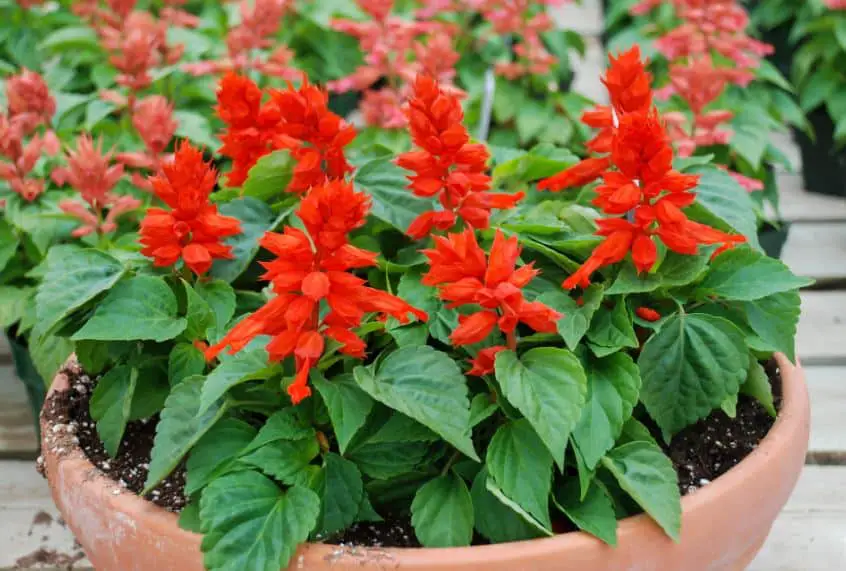Salvia’s massive summer-long bloom cycle and capacity to survive hot, dry conditions make it a favorite among gardeners. These beautiful plants, sometimes known as sage, are used for bulk and border plantings. Salvia flowers grow nicely in pots and create great-cut flowers. While the majority of species enjoy full light, can salvias tolerate shade?

Salvia Light Needs
A member of the mint family, the salvia genus is thought to have between 700 and 3000 species. Most salvia species demand 6 to 8 hours of direct sunlight daily, including culinary sage (Salvia officinalis).
Certain salvia species can tolerate 3 to 6 hours of partial shadow exposure daily. However, they may not bloom as abundantly in less sunny parts of the garden. Certain ornamental salvia species can endure dark areas with fewer than four hours of sunshine each day and prefer partial sun.
Salvia: Part-Shade Species
Consider these salvia varieties that can handle growing circumstances other than the full sun when choosing salvias for partial shade flower gardens:
- Bedding sage (Salvia splendens) — This well-known salvia species, widely accessible in gardening supply stores, has flower spikes that are 8 to 30 inches (20-76 cm) tall. Newer types of bedding sage provide many bloom colors, including purple, orange, salmon, and white. They are often known as scarlet sage for their lovely red blossoms.
- Black and Blue sage (Salvia guarnitica) — Named for its cobalt blue flowers or black calyx, Black and Blue salvia can reach a height of 1.5 meters and is resilient in USDA plant hardiness zones 7 to 10.
- Cleveland sage (Salvia clevelandii) — This is a woody shrub-like plant with greyish-green leaves and is one of the most fragrant salvia species. In late April, purple flowers bloom on it.
- Creeping sage (Salvia sonomensis) — This plant has silvery green leaves and is often used as a ground cover. Throughout the spring and the beginning of the summer, it blooms in bluish-violet spikes.
- Forsythia sage (Salvia madrensis) — The spiky yellow blooms of Forsythia sage add lovely color to the autumn and winter garden in frost-free areas. This perennial may grow as tall as 2 meters (7 feet).
- Salvia coccinea (Red, Blood, or Texas Sage) — While this sage has common names with other salvia species, it is vivid red, and 10-inch (25-cm) flower spikes are what gave it its name. This quick-growing subshrub may grow to 2 to 4 feet (0.6–1.2 meters). Cultivars now have white, pink, salmon, or orange blooms.
- Sticky Sage (Salvia glutionsa) — This plant, which gets its name from the glutinous hairs that coat it, has lovely 12-inch (30 cm) spikes of yellow flowers with maroon specks.
Salvia and shade sage species
Choose these salvia species for shadow regions if you are seeking colorful, flowering plants to thrive beneath trees or in dimly lit sections of the garden. During all three, like some shade, they may still grow with less light.
- Hummingbird sage (Salvia spathacea) — This plant blooms in the spring and has delicious fragrant petals. It is named for its tubular flowers that attract hummingbirds. Hummingbird sage comes in a range of vibrant flowering varieties and grows to a height of 12 to 36 inches (30-91 cm). In regions with mild winters, this shrub maintains its evergreen status. In USDA zones 8 to 11, winter is hardy.
- Japanese Yellow sage (Salvia koyamae) — Because of its creeping growth pattern and leaves that seldom grows higher than 12 inches (30 cm), Japanese yellow sage is an excellent ground cover for shaded places. Flowers’ 18 to 24-inch (46-61 cm) long, lemon-yellow spikes first bloom in late summer and early autumn—zones 5 through 9 of the USDA.
- Himalayan Cloud Sage (Salvia nubicola) — Himalayan Cloud Sage is a perennial herb that thrives in shaded sections of the garden and is native to the steep slopes of the Middle East and portions of Eurasia. Flowers grow on 10-inch (25 cm) light yellow spikes with maroon undertones. Deadhead this plant for a second wave of blooms later in the season. USDA zones 7 through 11 are winter-hardy.


